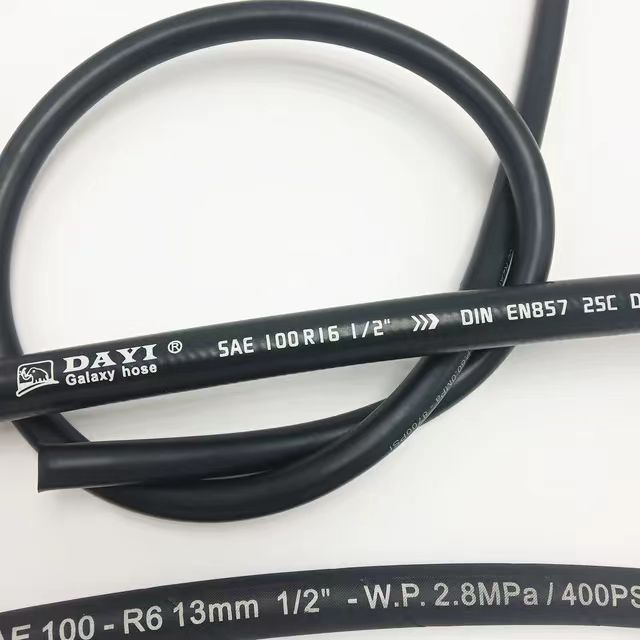335345435
Nov . 27, 2024 04:37 Back to list
High Pressure Rubber Fuel Hose for Reliable Performance in Challenging Conditions
The Importance of Rubber High-Pressure Fuel Lines in Modern Automotive Engineering
In the world of automotive engineering, the quality and reliability of fuel delivery systems are paramount for optimal vehicle performance. One of the critical components of these systems is the rubber high-pressure fuel line. This article explores the significance, materials, construction, and advantages of rubber high-pressure fuel lines in modern vehicles.
The Role of High-Pressure Fuel Lines
High-pressure fuel lines are essential conduits that transport fuel from the tank to the engine's fuel injectors. These lines must withstand the forces generated by the fuel pumps, which operate at high pressures, in some cases exceeding 50 psi or even more, depending on the vehicle's design. A failure in the fuel line system can lead to decreased engine performance, fuel leaks, and even pose serious safety hazards.
Materials and Construction
Rubber has been a longstanding choice for manufacturing high-pressure fuel lines due to its flexibility, resilience, and ability to withstand extreme conditions. Traditionally, automotive-grade rubber is combined with synthetic materials such as nitrile or fluorocarbon to enhance its durability. These rubber compounds are designed to resist not only the pressure exerted by the fuel but also the corrosive properties of gasoline and diesel.
The construction of a rubber high-pressure fuel line typically involves multiple layers. The inner layer is often a smooth lining that minimizes fuel turbulence and ensures optimal flow. This is followed by a reinforced layer, usually made of woven textiles or steel mesh, which provides strength and prevents the line from collapsing under pressure. The outer layer serves as a protective barrier against environmental factors such as heat, moisture, and ozone—elements that can degrade rubber over time.
Advantages of Rubber High-Pressure Fuel Lines
rubber high pressure fuel line

1. Flexibility and Ease of Installation Rubber fuel lines are known for their flexibility, allowing them to be easily routed in various vehicle layouts. This adaptability simplifies the installation process and reduces the need for additional connectors, which can be potential leak points.
2. Vibration Dampening Vehicles experience significant vibrations from the engine and road irregularities. Rubber's natural properties allow fuel lines to absorb these vibrations, minimizing stress on the connectors and reducing the likelihood of failures.
3. Temperature Resistance A high-quality rubber fuel line can maintain its integrity over a wide range of temperatures. They can operate effectively in the extreme heat produced by modern engines and the cold conditions experienced in various climates.
4. Chemical Resistance The life expectancy of a fuel line is largely determined by its resistance to the fuels it carries. Modern rubber compositions are engineered to withstand the chemical effects of ethanol-blended fuels, which are increasingly common in the market.
5. Cost-Effectiveness While there are alternatives such as stainless steel or plastic tubing, rubber high-pressure fuel lines are generally more cost-effective to manufacture and install. Their longevity and reliability further justify their use in economically-minded vehicle designs.
Conclusion
Rubber high-pressure fuel lines are a vital component of automotive fuel systems, playing a critical role in ensuring engine efficiency and safety. As advancements in rubber technology continue, the next generation of fuel lines will likely become even more resilient, safe, and efficient. Their blend of flexibility, durability, and cost-effectiveness makes rubber high-pressure fuel lines an indispensable asset for modern vehicles, allowing manufacturers to meet the increasing demands for performance and reliability in today's automotive landscape.
In summary, while they may seem like small components in the grand scheme of automotive engineering, rubber high-pressure fuel lines are a testament to the intricate balance of safety, performance, and innovation that defines modern vehicles. Their importance cannot be overstated; without them, the entire fuel delivery system would falter, underscoring the need for continued focus on the materials and engineering behind these essential components.
-
SAE 100 R17 Black Smooth Cover Hydraulic Hose
NewsMar.07,2025
-
SAE 100 R17 Black Smooth Cover Hydraulic Hose
NewsMar.07,2025
-
SAE 100 R17 Black Smooth Cover Hydraulic Hose
NewsMar.07,2025
-
SAE 100 R17 Black Smooth Cover Hydraulic Hose
NewsMar.07,2025
-
SAE 100 R17 Black Smooth Cover Hydraulic Hose
NewsMar.07,2025
-
steel wire braided hydraulic hose
NewsMar.07,2025



